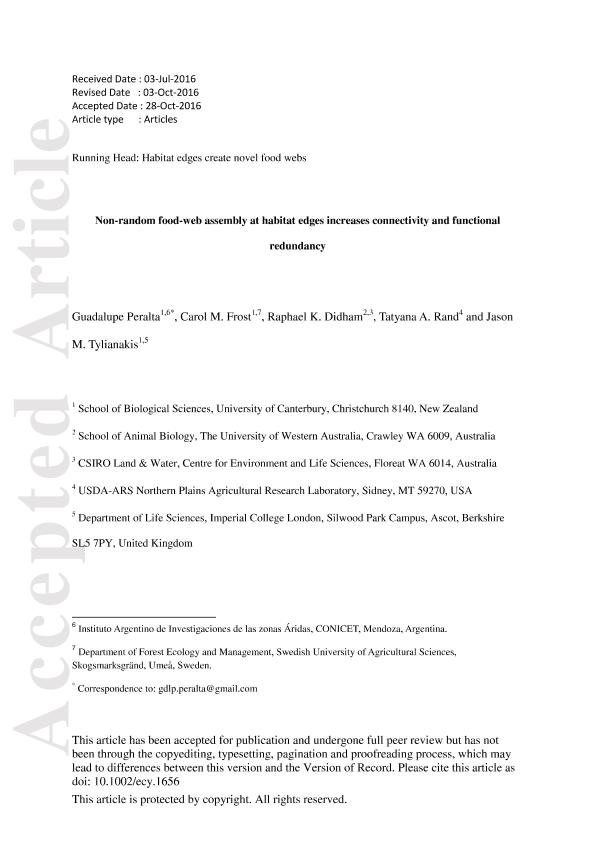Mostrar el registro sencillo del ítem
dc.contributor.author
Peralta, Guadalupe

dc.contributor.author
Frost, Carol M.
dc.contributor.author
Didham, Raphael K.
dc.contributor.author
Rand, Tatyana A.
dc.contributor.author
Tylianakis, Jason M.
dc.date.available
2018-04-23T21:52:48Z
dc.date.issued
2017-03
dc.identifier.citation
Peralta, Guadalupe; Frost, Carol M.; Didham, Raphael K.; Rand, Tatyana A.; Tylianakis, Jason M.; Non-random food-web assembly at habitat edges increases connectivity and functional redundancy.; Ecological Society of America; Ecology; 98; 4; 3-2017
dc.identifier.issn
0012-9658
dc.identifier.uri
http://hdl.handle.net/11336/43176
dc.description.abstract
Habitat fragmentation dramatically alters the spatial configuration of landscapes, with the creation of artificial edges affecting community structure and dynamics. Despite this, it is not known how the different food webs in adjacent habitats assemble at their boundaries. Here we demonstrate that the composition and structure of herbivore-parasitoid food webs across edges between native and plantation forests are not randomly assembled from those of the adjacent communities. Rather, elevated proportions of abundant, interaction-generalist parasitoid species at habitat edges allowed considerable interaction rewiring, which led to higher linkage density and less modular networks, with higher parasitoid functional redundancy. This was in spite of high overlap in host composition between edges and interiors. We also provide testable hypotheses for how food webs may assemble between habitats with lower species overlap. In an increasingly fragmented world, non-random assembly of food webs at edges may increasingly affect community dynamics at the landscape level.
dc.format
application/pdf
dc.language.iso
eng
dc.publisher
Ecological Society of America

dc.rights
info:eu-repo/semantics/openAccess
dc.rights.uri
https://creativecommons.org/licenses/by-nc-sa/2.5/ar/
dc.subject
Edge Effects
dc.subject
Food-Web Structure
dc.subject
Generalism
dc.subject
Host
dc.subject
Native Forest
dc.subject
Network Dissimilarity
dc.subject
Parasitoid
dc.subject
Plantation Forest
dc.subject
Rewiring of Interactions
dc.subject
Species Composition
dc.subject.classification
Otras Ciencias Biológicas

dc.subject.classification
Ciencias Biológicas

dc.subject.classification
CIENCIAS NATURALES Y EXACTAS

dc.title
Non-random food-web assembly at habitat edges increases connectivity and functional redundancy.
dc.type
info:eu-repo/semantics/article
dc.type
info:ar-repo/semantics/artículo
dc.type
info:eu-repo/semantics/publishedVersion
dc.date.updated
2018-04-16T14:04:47Z
dc.journal.volume
98
dc.journal.number
4
dc.journal.pais
Estados Unidos

dc.journal.ciudad
Brooklyn
dc.description.fil
Fil: Peralta, Guadalupe. Consejo Nacional de Investigaciones Científicas y Técnicas; Argentina. University Of Canterbury; Nueva Zelanda
dc.description.fil
Fil: Frost, Carol M.. University Of Canterbury; Nueva Zelanda
dc.description.fil
Fil: Didham, Raphael K.. University of Western Australia; Australia
dc.description.fil
Fil: Rand, Tatyana A.. Northern Plains Agricultural Research Laboratory; Estados Unidos
dc.description.fil
Fil: Tylianakis, Jason M.. University Of Canterbury; Nueva Zelanda
dc.journal.title
Ecology

dc.relation.alternativeid
info:eu-repo/semantics/altIdentifier/doi/http://dx.doi.org/10.1002/ecy.1656
dc.relation.alternativeid
info:eu-repo/semantics/altIdentifier/url/https://esajournals.onlinelibrary.wiley.com/doi/abs/10.1002/ecy.1656
Archivos asociados
